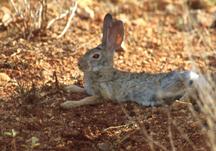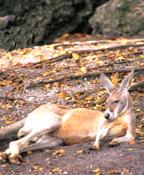Desert: Animals
At first glance, deserts may appear to be without animal life. However, deserts are home to many reptiles, insects, birds, and small mammals. The kangaroo mice of North America and the bilby and red kangaroo of Australia are just a few examples of small mammals that live in the desert. Most large animals have not adapted to desert life. Their size prevents them from finding shelter from the Sun's heat and they are not able to store water for future use. Animals that do survive in the desert have developed a number of adaptations.
At first glance, deserts may appear to be without animal life. However, deserts are home to many reptiles, insects, birds, and small mammals. The kangaroo mice of North America and the bilby and red kangaroo of Australia are just a few examples of small mammals that live in the desert. Most large animals have not adapted to desert life. Their size prevents them from finding shelter from the Sun's heat and they are not able to store water for future use. Animals that do survive in the desert have developed a number of adaptations.
The most universal behavioral adaptation used by small mammals, reptiles, and insects to deal with high temperatures is staying in the shadow (shade) of plants or rocks, thus avoiding the direct rays of the Sun. These animals also seek shelter by burrowing into the ground. Just as a basement room is cooler than an above-ground room, a burrow, even a few feet underground, can decrease the temperature by several degrees. Another behavioral adaptation used by desert animals is to remain inactive during the hot daylight hours. They hunt at night when temperatures are cool and when there is less risk of losing precious body water. Animals that use this adaptation are referred to as nocturnal. Some animals get all of the water they need from the insects, bulbs, and seeds they eat. They will not drink water even when it is available.
 Some animals have developed salt glands, a physical adaptation that allows the secretion of salt without the loss of water. The absence of sweat glands, and the concentration of urine are other physical adaptations made by desert animals. Because fat intensifies heat, a unique physical adaptation of some desert animals is the storage of fat in humps or tails, rather than throughout the entire body.
Some animals have developed salt glands, a physical adaptation that allows the secretion of salt without the loss of water. The absence of sweat glands, and the concentration of urine are other physical adaptations made by desert animals. Because fat intensifies heat, a unique physical adaptation of some desert animals is the storage of fat in humps or tails, rather than throughout the entire body.

No comments:
Post a Comment